
Forsythia, is a genus of flowering plants in the olive family Oleaceae. There are about 11 species, mostly native to eastern Asia, but one native to southeastern Europe. Forsythia – also one of the plant's common names – is named after William Forsyth.

Deutzia is a genus of about 60 species of flowering plants in the family Hydrangeaceae, native to eastern and central Asia, and Central America and also Europe. By far the highest species diversity is in China, where 50 species occur.
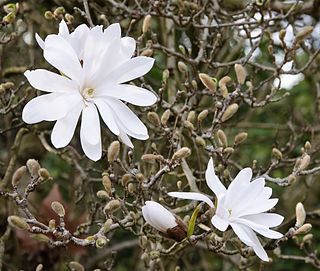
Magnolia stellata, the star magnolia, is a slow-growing deciduous shrub or small tree native to Japan. It bears large, showy white or pink flowers in early spring, before its leaves open. This species is closely related to the Kobushi magnolia, and is treated by many botanists as a variety or even a cultivar of that. However, Magnolia stellata was accepted as a distinct species in the 1998 monograph by Hunt.
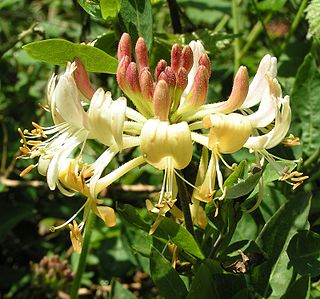
Lonicera periclymenum, common names honeysuckle, common honeysuckle, European honeysuckle, or woodbine, is a species of flowering plant in the family Caprifoliaceae native to much of Europe, North Africa, Turkey and the Caucasus. It is found as far north as southern Norway, Sweden and Finland.

Hydrangea macrophylla is a species of flowering plant in the family Hydrangeaceae, native to Japan. It is a deciduous shrub growing to 2 m (7 ft) tall by 2.5 m (8 ft) broad with large heads of pink or blue flowers in summer and autumn. Common names include bigleaf hydrangea, French hydrangea, lacecap hydrangea, mophead hydrangea, and hortensia. It is widely cultivated in many parts of the world in many climates. It is not to be confused with H. aspera 'Macrophylla'.
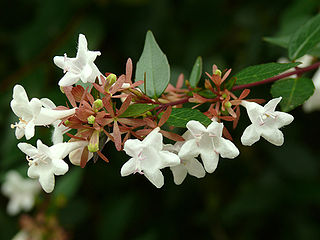
Abelia × grandiflora is a hybrid species of flowering plant in the honeysuckle family Caprifoliaceae, raised by hybridising A. chinensis with A. uniflora.
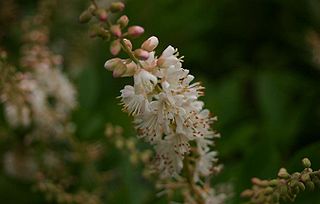
Clethra alnifolia, the coastal sweetpepperbush or summer sweet, is a species of flowering plant in the genus Clethra of the family Clethraceae, native to eastern North America from southern Nova Scotia and Maine south to northern Florida, and west to eastern Texas. It is a deciduous shrub which grows in wetlands, bogs and woodland streams.

Chaenomeles speciosa, the flowering quince, Chinese quince or Japanese quince, is a thorny deciduous or semi-evergreen shrub native to eastern Asia. It is taller than another commonly cultivated species, C. japonica, usually growing to about 2 m. The flowers are usually red, but may be white or pink. The fruit is a fragrant, hard pome that resembles a quince.

Viburnum plicatum is a species of flowering plant in the family Adoxaceae, native to mainland China, Korea, Japan, and Taiwan. The Latin specific epithet plicatum means "pleated", referring to the texture of the leaves.

Viburnum × burkwoodii, the Burkwood viburnum, is a hybrid flowering plant in the family Adoxaceae. It is a cross of garden origin between V. carlesii and V. utile, grown for its early, strongly scented flowers.

Hydrangea serrata is a species of flowering plant in the family Hydrangeaceae, native to mountainous regions of Korea and Japan. Common names include mountain hydrangea and tea of heaven. Growing to 1.2 m (4 ft) tall and broad, it is a deciduous shrub with oval leaves and panicles of blue and pink flowers in summer and autumn (fall). It is widely cultivated as an attractive ornamental shrub throughout the world in areas with suitable climate and soil.

Hydrangea paniculata, or panicled hydrangea, is a species of flowering plant in the family Hydrangeaceae native to southern and eastern China, Korea, Japan and Russia (Sakhalin). It was first formally described by Philipp Franz von Siebold in 1829.

Abelia chinensis, commonly known as Chinese abelia, is a species of flowering plant in the honeysuckle family Caprifoliaceae. It is a semi-evergreen, densely branched shrub with dark green foliage.

Styrax hemsleyanus (老鸹铃), the Hemsley snowball, is a species of flowering plant in the family Styracaceae, native to central China. Growing to 12 m (39 ft) tall by 5 m (16 ft) broad, it is a conical deciduous tree with large rounded leaves, 12 cm (5 in) long, and clusters of cup-shaped flowers in early summer.
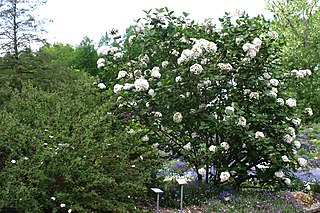
Viburnum carlesii, the arrowwood or Korean spice viburnum, is a species of flowering plant in the family Adoxaceae, native to Korea and Japan and naturalised in Ohio, USA. Growing to 2 m (7 ft) tall and broad, it is a bushy deciduous shrub with oval leaves which are copper-coloured when young. Round clusters of red buds open to strongly scented, pale pink flowers in late spring. These are followed in late summer by oval red fruits ripening to black in autumn.
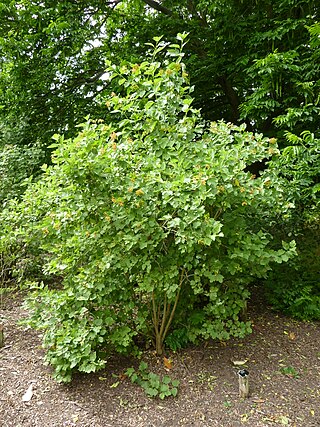
Viburnum sargentii is a species of flowering plant in the family Adoxaceae, native to north eastern Asia. Growing to 3 m (10 ft) tall and broad, it is a substantial deciduous shrub with 3-lobed, maple-like leaves, often turning red in autumn. Flat white flower-heads (cymes) resembling those of lacecap hydrangeas are borne in early summer. The outer florets are saucer-shaped and sterile, while the central tubular flowers are fertile. The flowers are followed in autumn by globose red berries.

Lonicera tragophylla, the Chinese honeysuckle, is a species of flowering plant in the family Caprifoliaceae, native to Central China, where it inhabits forest, scrub and rocky crevices. Growing to 6 m (20 ft) tall by 1.5 m (4.9 ft) wide, it is a deciduous climbing shrub with grey-green leaves and trumpet-shaped, pure rich yellow flowers in late summer and autumn. Unlike many of its relatives in the honeysuckle genus Lonicera, it is unscented.

Viburnum × bodnantense, the Bodnant viburnum, is a Group of hybrid flowering plant cultivars of garden origin. They originate in a cross between V. farreri and V. grandiflorum made by Charles Puddle, head gardener to Lord Aberconway at Bodnant Garden, Wales around 1935.

Weigela coraeensis is a species of flowering plant in the family Caprifoliaceae. It is native to Japan.

Lonicera × purpusii, the Purpus honeysuckle, is a hybrid species of flowering plant in the family Caprifoliaceae. It originated as a cross of garden origin between two Chinese species, L. fragrantissima and L. standishii.





















